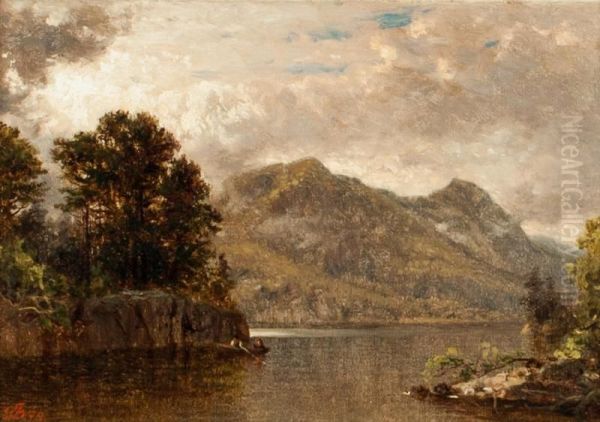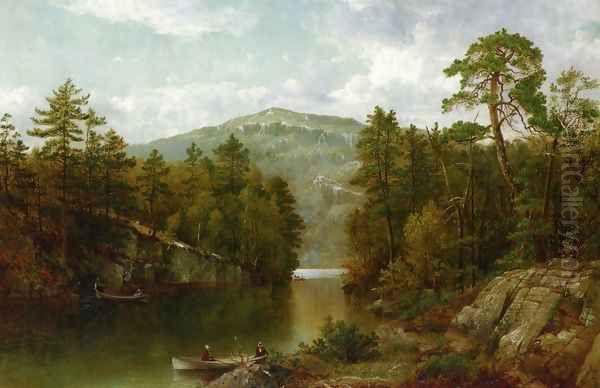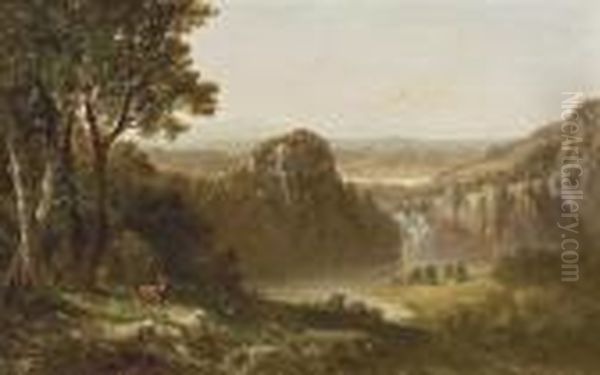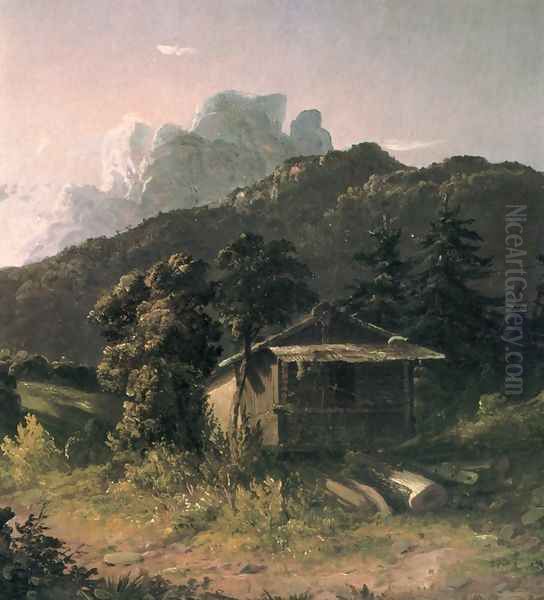David Johnson (1827-1908) stands as a significant figure in nineteenth-century American art, particularly recognized as a prominent member of the second generation of the Hudson River School. An American national, born in New York City, Johnson dedicated his career to landscape painting, capturing the natural beauty of the American Northeast with remarkable precision and sensitivity. His artistic journey reflects the evolution of American landscape painting during his time, moving from meticulous realism towards broader, more atmospheric styles.
Early Life and Artistic Formation
Born in New York City in 1827, David Johnson's artistic inclinations emerged early. He sought formal training at the prestigious National Academy of Design in New York, enrolling in the antique class in 1845 and 1846. This foundational education provided him with the technical skills necessary for his future career. Beyond the Academy, Johnson benefited from the guidance of established artists.
He studied briefly, yet significantly, with Jasper Francis Cropsey, a leading figure of the Hudson River School known for his vibrant autumnal landscapes. Johnson also received instruction from John William Casilear, another respected landscape painter associated with the school, known for his gentler, more poetic scenes. These mentorships were crucial in shaping Johnson's early style and connecting him to the prevailing artistic currents of the time. He began his professional career around 1849, quickly establishing himself as a dedicated landscape painter.
The Hudson River School Context
The Hudson River School, broadly active from the 1820s to the 1870s, was America's first true school of landscape painting. Its artists sought to depict the American wilderness, often celebrating its grandeur and sublime beauty as a reflection of national identity and divine presence. The first generation, led by figures like Thomas Cole and Asher B. Durand, established the movement's core tenets.
David Johnson belonged to the second generation, which emerged around the mid-century. This group, including artists like John Frederick Kensett, Sanford Robinson Gifford, Frederic Edwin Church, and Johnson's teacher Jasper Francis Cropsey, built upon the foundations laid by their predecessors. While still focused on nature, many second-generation artists explored light and atmosphere with greater subtlety, leading to the development of Luminism. Johnson was a key participant in this evolution.
Realism and the Rise of Luminism

In his early career, Johnson demonstrated a strong commitment to realism. His works from the 1850s onwards are characterized by their clarity, meticulous detail, and precise rendering of natural forms. He possessed a remarkable ability to capture the specific textures of rocks, the intricate patterns of foliage, and the subtle reflections on water. His studies often focused on specific trees or geological formations, grounding his finished paintings in careful observation.
Johnson became particularly associated with Luminism, a style flourishing within the Hudson River School framework during the mid-century. Luminism is characterized by its emphasis on tranquil scenes, subtle gradations of light, serene atmospheres, and often, smooth, almost invisible brushwork. Johnson, alongside contemporaries like John F. Kensett and Sanford Robinson Gifford, excelled in capturing these effects. His paintings often feature calm bodies of water, expansive skies, and a palpable sense of stillness, rendered with a cool, clear light. His small-scale, tightly composed, and richly colored works are exemplary of this approach.
Representative Works and Peak Career
Johnson's dedication to detailed observation is evident in his early dated work, Haines Falls, Kauterskill Clove (1849), a subject popular among Hudson River School artists, likely reflecting his studies with Cropsey and Kensett in the Catskill Mountains. Throughout the 1850s, 60s, and early 70s, Johnson produced many of his most acclaimed works, focusing on landscapes in New York State (especially Lake George and the Catskills), New Hampshire (the White Mountains, including Profile Rock), and Connecticut (like the Natural Bridge).
His painting Morning, Lake George is considered one of his masterpieces, showcasing his skill in rendering atmospheric perspective and the delicate effects of morning light on water and mountains. This period marked the height of his career and recognition. He exhibited regularly at the National Academy of Design, the Brooklyn Art Association, and the Union League Club of New York, gaining critical acclaim and patronage.
Recognition and Honors
Johnson's talent did not go unnoticed by the artistic establishment. He was elected an Associate Member of the National Academy of Design in 1860 and achieved the status of full Academician just one year later, in 1861. This recognition solidified his position within the New York art world.
His work was included in major national and international exhibitions. He showed paintings in Boston, Chicago, and Philadelphia, winning a first-class medal at the Centennial Exposition in Philadelphia in 1876. Significantly, his work was also accepted into the prestigious Paris Salon of 1877, indicating his growing reputation beyond American shores. These accolades underscored the high regard in which his detailed, luminous landscapes were held during his peak years.
Influence of the Barbizon School

Beginning in the mid-1870s, a noticeable shift occurred in Johnson's style. Like many American artists of his generation, he became increasingly influenced by the French Barbizon School. Painters such as Jean-Baptiste-Camille Corot, Charles-François Daubigny, and Narcisse Virgilio Díaz de la Peña championed a more intimate, pastoral, and tonal approach to landscape, often working directly from nature with looser brushwork.
Johnson began to adopt some of these characteristics. His later works often feature softer edges, a more generalized treatment of forms, a focus on tonal harmony rather than sharp detail, and more pastoral, often bucolic, subject matter. The brushwork became more visible and the overall mood more subjective and poetic, moving away from the crisp objectivity of his earlier Luminist phase. This transition reflected broader changes in artistic taste, as the detailed realism of the Hudson River School gradually gave way to styles influenced by European trends.
Later Career and Critical Reception
While Johnson continued to paint into his later years, the shift towards a Barbizon-influenced style met with a mixed reception. Some critics and perhaps fellow artists, accustomed to the meticulous detail of his earlier work, felt that his later paintings lacked the precision and power that had initially brought him fame. The darker palette and looser handling were sometimes seen as a decline from his peak achievements.
Compounding this was a general shift in artistic fashion away from the Hudson River School aesthetic. These factors contributed to financial difficulties for Johnson in his later life. He eventually had to give up his New York City studio, a sign of his waning prominence in the art market of the late nineteenth century. Despite these challenges, he continued to produce work reflecting his enduring love for the landscape.
Technique and Artistic Process
David Johnson's art was underpinned by a rigorous process of observation and study. He was known for making numerous preparatory drawings and oil sketches directly from nature (plein air). These studies, often focusing on specific elements like a single tree, a rock formation, or a particular effect of light, formed the basis for his larger studio compositions.

This dedication to empirical study ensured the botanical and geological accuracy that critics praised in his work. His technique involved careful layering of paint to achieve smooth surfaces and subtle transitions of light and color, especially during his Luminist phase. Even in his later, looser style, a foundation of strong draftsmanship and understanding of natural forms remained evident. His ability to render the textures of bark, stone, moss, and water with such fidelity was a hallmark of his craft.
Contemporaries and Artistic Milieu
Johnson operated within a vibrant artistic community. His teachers, Cropsey and Casilear, and his close associate Kensett, were central figures. He exhibited alongside nearly all major American landscape painters of the era, including Albert Bierstadt, known for his grand Western scenes, and Worthington Whittredge, who also transitioned towards Barbizon influences.
He was part of the milieu that included figures like Sanford Robinson Gifford, celebrated for his mastery of light and atmosphere, and Frederic Edwin Church, famous for his large-scale, dramatic landscapes of both North and South America. Johnson's engagement with Luminism placed him in dialogue with Kensett and Gifford, while his later shift reflected trends also seen in the work of George Inness, who fully embraced a more subjective, Tonalist style derived from Barbizon principles. His interactions, whether cooperative or competitive, were part of the dynamic evolution of American art in the 19th century.
Legacy and Re-evaluation
David Johnson passed away in Walden, New York, in 1908. While his reputation had somewhat diminished by the end of his life, the enduring quality of his work ensured his place in American art history. Following a period where the Hudson River School was relatively overlooked, the latter half of the 20th century saw a resurgence of interest in these artists.
Scholarly research, particularly from the 1980s onwards, helped to re-evaluate Johnson's contributions. Today, he is recognized as one of the most skilled landscape painters of the second-generation Hudson River School. His works are held in major museum collections across the United States, including the Metropolitan Museum of Art in New York, the Museum of Fine Arts, Boston, the National Gallery of Art in Washington D.C., and the Amon Carter Museum of American Art in Fort Worth, Texas. His paintings continue to be admired and sought after, achieving significant prices at auction, confirming his lasting importance.
Conclusion: A Master of Detail and Light

David Johnson's legacy rests on his exceptional skill in capturing the American landscape with both detailed precision and atmospheric sensitivity. As a key figure in the Hudson River School's second generation, he contributed significantly to the development of Luminism, creating works renowned for their clarity, tranquility, and masterful handling of light. His meticulous studies of nature, particularly his renderings of rocks and trees, remain testaments to his observational powers.
While his later adoption of Barbizon principles marked a departure from his earlier style and drew some criticism, it also demonstrated his engagement with evolving artistic ideas. Despite facing challenges in his later career, David Johnson's body of work endures as a vital part of the American landscape tradition, celebrated for its technical brilliance, its quiet beauty, and its affectionate portrayal of the Northeastern wilderness. He remains an important artist for understanding the nuances and evolution of American painting in the nineteenth century.